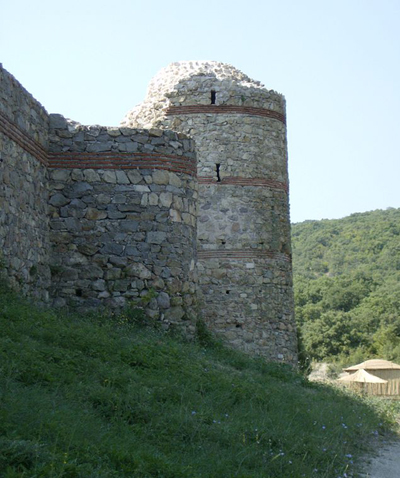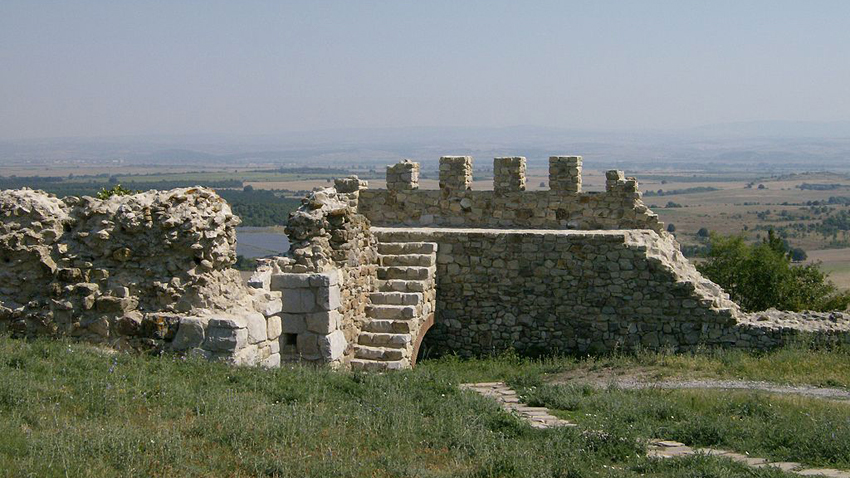One of Bulgaria’s emblematic medieval fortresses rises close to Mezek village, six kilometers from Svilengrad and just one from the border with Greece. It was built at the end of the 11th and the beginning of the 12th century, probably during the reign of Byzantine Emperor Alexius I Comnenus. It stood on Byzantium’s outer border, and was frequently the target of raids by the barbarians on all sides. In our day the historic monument is visited by a great many who want to find out more about Bulgarian history.
 The fortress walls are made of quarrystone and are held together by mortar and lined with three different kinds of bricks on the outside. The gate is on the Western wall; the Southern wall was the most vulnerable to attack so it is 2.6 meters thick and crowned with five observation and defence turrets. Up until the turn of the 20th century the fortress was very well preserved, but around the year 1900 blocks were taken from it for use in the construction of the army barracks in Svilengrad nearby. The Northern fortress wall is the most badly damaged - on the inner side it has been razed right down to ground level.
The fortress walls are made of quarrystone and are held together by mortar and lined with three different kinds of bricks on the outside. The gate is on the Western wall; the Southern wall was the most vulnerable to attack so it is 2.6 meters thick and crowned with five observation and defence turrets. Up until the turn of the 20th century the fortress was very well preserved, but around the year 1900 blocks were taken from it for use in the construction of the army barracks in Svilengrad nearby. The Northern fortress wall is the most badly damaged - on the inner side it has been razed right down to ground level.
In our day the Mezek fortress has been declared a national archaeological monument of culture and as of 2009 it has been on the 100 National Tourist sites list. The stream of tourists has been rising steadily since its restoration in 2013.
Under a Svilengrad municipality project, an ancient Byzantine settlement has been recreated at the foot of the stone wall, with tents for the king, the horsemen and even prison cells. On weekends and public holidays everything around the fortress springs back to life thanks to the members of the Mezek authentic folklore club. “In summer we welcome a great many tourists here, including from America, Russia, Britain,” says Huben Skerlev, archaeological complex guide and adds:
“This is a Byzantine fortress and it was built with the express purpose of defending the lands between the rivers Arda and Maritsa. Hence the name of the village nearby, Mezek meaning dividing-line in Greek as it rises between two rivers, between two borderlines. The entire Maritsa valley right up to the first hills of Sakar Mount, all the surrounding land can be seen from the fortress. In its day it was a major fortification. It spreads over an area of almost 0.7 hectares, with 9 turrets and thick stone walls. It was impregnable; the location itself makes it impenetrable. Imagine you are an enemy army moving towards the fortress entrance - you would be under constant fire by the soldiers. By the time the troops reached the entrance they would be decimated. The settlement itself was outside the fortress, itself surrounded by a smaller wall. In the face of approaching danger, people would go inside the fortress and there, behind its impenetrable walls, they would take up position to defend themselves. Years later, the village was moved further from the fortress. As the only buildings here were connected with the garrisons, archaeologists have not discovered any traces of houses or of a chapel, as they thought they would. What they found behind the fortress walls was mostly spearheads and arrows, spurs, horseshoes, 12th-13th century bronze Tatar coins, medieval pottery, stone grinders, all of them things that give a fair idea of what garrison life was like in those times. The fortress near Mezek was in use right up till the 14th century, the time of the Ottoman invasion and had never fallen into enemy hands. When the Ottomans invaded our lands, their armies were bigger, they came with artillery and were using gunpowder. They captured the fortress and used it for some time, but later decided to use its stones to build army barracks nearby which gradually undermined it. In recent years however, a great deal has been done for its restoration and conservation and it is now accessible to the numerous tourists coming here to find out more about its tumultuous past,” says in conclusion Huben Skerlev.

English version: Milena Daynova
The Regional Museum of History in Turgovishte in the old, Revival-time part of town, called Varosha, houses over 30,000 exhibits. Some of the artifacts, discovered by archaeologists in these parts, go as far back as the Neolithic age. The..
The house of Vasil Levski, Bulgaria’s national hero and organizer of the anti-Ottoman movement in the 19th c. has always been one of the most visited memorial museums in this country. The building itself is modest and its style is typical for..
In Bulgaria’s Northwestern corner a fantastic rocky landscape meets the eye – the towering Belogradchik rocks inspire awe and deference in any onlooker. The area is studded with yawning abysses, canyons and caves, gateways to the kingdom of..

+359 2 9336 661
